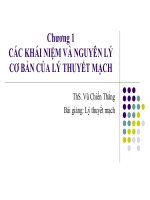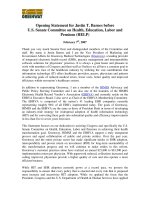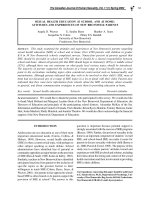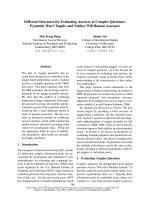Trichoderma spp., including T. harzianum, T. viride, T. koningii, T. hamatum and other spp. pptx
Bạn đang xem bản rút gọn của tài liệu. Xem và tải ngay bản đầy đủ của tài liệu tại đây (79.48 KB, 6 trang )
Trichoderma spp., including T. harzianum, T. viride, T. koningii, T. hamatum and
other spp.
Deuteromycetes, Moniliales (asexual classification system)
(Ascomycetes, Hypocreales, usually Hypocrea spp., are sexual anamorphs, this life stage
is lacking or unknown for biocontrol strains)
by G. E. Harman, Cornell University, Geneva, NY 14456
What are Trichoderma?
Trichoderma spp. are fungi that are present in nearly all soils and other diverse habitats.
In soil, they frequently are the most prevalent culturable fungi.
They are favored by the presence of high levels of plant roots, which they colonize
readily. Some strains are highly rhizosphere competent, i.e., able to colonize and grow on
roots as they develop. The most strongly rhizosphere competent strains can be added to
soil or seeds by any method. Once they come into contact with roots, they colonize the
root surface or cortex, depending on the strain. Thus, if added as a seed treatment, the
best strains will colonize root surfaces even when roots a meter or more below the soil
surface and they can persist at useful numbers up to 18 months after application.
However, most strains lack this ability.
In addition to colonizing roots, Trichoderma spp. attack, parasitize and otherwise gain
nutrition from other fungi. Since Trichoderma spp. grow and proliferate best when there
are abundant healthy roots, they have evolved numerous mechanisms for both attack of
other fungi and for enhancing plant and root growth. Several new general methods for
both biocontrol and for causing enhancement of plant growth have recently been
demonstrated and it is now clear that there must be hundreds of separate genes and gene
products involved in these processes. A recent list of mechanisms follows.
Mycoparasitism
Antibiosis
Competition for nutrients or space
Tolerance to stress through enhanced root and plant development
Solubilization and sequestration of inorganic nutrients
Induced resistance
Inactivation of the pathogen’s enzymes
Taxonomy and genetics
Most Trichoderma strains have no sexual stage but instead produce only asexual spores.
However, for a few strains the sexual stage is known, but not among strains that have
usually been considered for biocontrol purposes. The sexual stage, when found, is within
the Ascomycetes in the genus Hypocrea. Traditional taxonomy was based upon
differences in morphology, primarily of the asexual sporulation apparatus, but more
molecular approaches are now being used. Consequently, the taxa recently have gone
from nine to at least thirty-three species.
Most strains are highly adapted to an asexual life cycle. In the absence of meiosis,
chromosome plasticity is the norm, and different strains have different numbers and sizes
of chromosomes. Most cells have numerous nuclei, with some vegetative cells possessing
more than 100. Various asexual genetic factors, such as parasexual recombination,
mutation and other processes contribute to variation between nuclei in a single organism
(thallus). Thus, the fungi are highly adaptable and evolve rapidly. There is great diversity
in the genotype and phenotype of wild strains.
While wild strains are highly adaptable and may be heterokaryotic (contain nuclei of
dissimilar genotype within a single organism) (and hence highly variable), strains used
for biocontrol in commercial agriculture are, or should be, homokaryotic (nuclei are all
genetically similar or identical). This, coupled with tight control of variation through
genetic drift, allows these commercial strains to be genetically distinct and nonvariable.
This is an extremely important quality control item for any company wishing to
commercialize these organisms.
Pathogens controlled
So far as the author is aware, different strains of Trichoderma control every pathogenic
fungus for which control has been sought. However, most Trichoderma strains are more
efficient for control of some pathogens than others, and may be largely ineffective against
some fungi. The recent discovery in several labs that some strains induce plants to "turn
on" their native defense mechanisms offers the likelihood that these strains also will
control pathogens other than fungi.
Life cycle
Fungal thalli are shown in the figure at the beginning of this web page. The organism
grows and ramifies as typical fungal hyphae, 5 to 10 µm in diameter. Asexual sporulation
occurs as single-celled, usually green, conidia (typically 3 to 5 µm in diameter) that are
released in large numbers. Intercalary resting chlamydospores are also formed, these also
are single celled, although two or more chlamydospores may be fused together.
Pesticide susceptibility
Trichoderma spp. possess innate resistance to most agricultural chemicals, including
fungicides, although individual strains differ in their resistance. Some lines have been
selected or modified to be resistant to specific agricultural chemicals. Most manufacturers
of Trichoderma strains for biological control have extensive lists of susceptibilities or
resistance to a range of pesticides.
Uses of Trichoderma
These versatile fungi are used commercially in a variety of ways, including the following:
Foods and textiles:
Trichoderma spp. are highly efficient producers of many extracellular enzymes. They are
used commercially for production of cellulases and other enzymes that degrade complex
polysaccharides. They are frequently used in the food and textile industries for these
purposes. For example, cellulases from these fungi are used in "biostoning" of denim
fabrics to give rise to the soft, whitened fabric stone-washed denim. The enzymes are
also used in poultry feed to increase the digestibility of hemicelluloses from barley or
other crops.
Biocontrol agents:
As noted, these fungi are used, with or without legal registration, for the control of plant
diseases. There are several reputable companies that manufacture government registered
products. Some of these companies are listed at the end of this web page. This site will
not knowingly list any nonregistered products or strains offered for sale in commercial
agriculture even though these products are common and their sale is widely ignored by
governmental regulatory agencies.
Plant growth promotion:
For many years, the ability of these fungi to increase the rate of plant growth and
development, including, especially, their ability to cause the production of more robust
roots has been known. The mechanisms for these abilities are only just now becoming
known.
Some of these abilities are likely to be quite profound. Recently, we have found that one
strain increases the numbers of even deep roots (at as much as a meter below the soil
surface). These deep roots cause crops, such as corn, and ornamental plants, such as
turfgrass, to become more resistant to drought.
Perhaps even more importantly, our recent research indicates that corn whose roots are
colonized by Trichoderma strain T-22 require about 40% less nitrogen fertilizer than corn
whose roots lack the fungus. Since nitrogen fertilizer use is likely to be curtailed by
federal mandate to minimize damage to estuaries and other oceanic environment (see
there are a number of other sites on the web
dealing with this topic, search for sites dealing with the ‘dead zone’) the use of this
organism may provide a method for farmers to retain high agricultural productivity while
still meeting new regulations likely to be imposed.
As a source of transgenes.
Biocontrol microbes, almost by definition, must contain a large number of genes that
encode products that permit biocontrol to occur. Several genes have been cloned from
Trichoderma spp. that offer great promise as transgenes to produce crops that are resistant
to plant diseases. No such genes are yet commercially available, but a number are in
development. These genes, which are contained in Trichoderma spp. and many other
beneficial microbes, are the basis for much of "natural" organic crop protection and
production.
Trichoderma
Usually recognized by fast-growing colonies producing white, green, or yellow cushions
of sporulating filaments. The fertile filaments or conidiophores produce side branches
bearing whorls of short phialides. The 1-celled spores (conidia) are produced
successively from the tips of the phailides and collect in small wet masses.
Trichoderma species are strongly antagonistic to other fungi. The exact nature of this
relationship is still not clear, but it appears that they kill other fungi with a toxin and then
consume them using a combination of lytic enzymes. This suggests they are actually
microbial predators. This antagonistic behaviour has led to their use as agents of
biological control of some fungi causing plant disease. On the other hand, they can be
serious pests in cultivated mushroom beds. Species of Trichoderma are common in soil
(especially water-logged soil), dung, and decaying plant materials. Holomorphs:
Hypocrea, Podostroma. Ref: Bissett, 1984, 1991a,b,c; Rifai 1969
Trichoderma spp.
(described by Persoon ex Gray in 1801)
Taxonomic classification
Kingdom: Fungi
Phylum: Ascomycota
Class: Euascomycetes
Order: Hypocreales
Family: Hypocreaceae
Genus: Trichoderma
Description and Natural Habitats
Trichoderma is a filamentous fungus that is widely distributed in the soil, plant material,
decaying vegetation, and wood. Hypocrea spp. are the teleomorph of some Trichoderma
species. Although it is commonly considered as a contaminant, Trichoderma may cause
infections in presence of certain predisposing factors.
Species
The genus Trichoderma has five species; Trichoderma harzianum, Trichoderma koningii,
Trichoderma longibrachiatum, Trichoderma pseudokoningii, and Trichoderma viride.
Morphological features of the conidia and phialides help in differentiation of these
species from each other. Apart from these, two other species, Trichoderma asperelum and
Trichoderma citrinoviride [1260] have been proposed. However, their identity and
clinical significance remain unconfirmed and doubtful [531].
See the summary of teleomorphs and synonyms for the Trichoderma spp.
Pathogenicity and Clinical Significance
Very few human cases due to Trichoderma have been identified. Trichoderma infections
are opportunistic [908] and develop in immunocompromised patients, such as
neutropenic cases and transplant recipients, as well as patients with chronic renal failure,
chronic lung disease, or amyloidosis. Peritonitis [319], pulmonary, perihepatic, and
disseminated infections [1924] have so far been reported.
Macroscopic Features
Colonies of Trichoderma grow rapidly and mature in 5 days. At 25°C and on potato
dextrose agar, the colonies are wooly and become compact in time. From the front, the
color is white. As the conidia are formed, scattered blue-green or yellow-green patches
become visible. These patches may sometimes form concentric rings. They are more
readily visible on potato dextrose agar compared to Sabouraud dextrose agar. Reverse is
pale, tan, or yellowish [531, 1295, 2144, 2202].
Microscopic Features
Septate hyaline hyphae, conidiophores, phialides, and conidia are observed. Trichoderma
longibrachiatum and Trichoderma viride may also produce chlamydospores.
Conidiophores are hyaline, branched, and may occasionally display a pyramidal
arrangement. Phialides are hyaline, flask-shaped, and inflated at the base. They are
attached to the conidiophores at right angles. The phialides may be solitary or arranged in
clusters. Conidia (3 µm in diameter, average) are one-celled and round or ellipsoidal in
shape. They are smooth- or rough-walled and grouped in sticky heads at the tips of the
phialides. These clusters frequently get disrupted during routine slide preparation
procedure for microscopic examination. The color of the conidia is mostly green [531,
1295, 2144, 2202].
Cellulase assays
Cellulase enzymes show activity during the ripening of some fruits, where their effects on
cell walls results in softening of the fruit. In cases of programmed cell death, such as the
formation of aerenchyma (large air spaces in the cortex of plants in flooded soils), and in
the abscission zones of leaves and fruits, cellulases are once again very active, breaking
down the cellulose walls of the dead cells. Two possible protocols are described here, a
gel diffusion assay method and a viscosity reduction assay method.
Gel diffusion method
A fruit extract is placed in a well in some agar containing carboxymethylcellulose
(CMC), and, as cellulase molecules diffuse outwards from the well, they destroy
cellulose molecules. The more concentrated the enzymes in the well, the larger the zone
of cellulose destruction.
-Prepare an agar gel containing 1.7% agar and 0.5% CMC (carboxymethylcellulose).
Pour this gel into petri dishes and allow it to set.
-After the gel has set, use a narrow cork-borer to punch small cylinders in the gel. Then,
using a mounted needle, remove each of these cylinders to create a series of similar sized
wells in the agar. Four or more wells can be put in a single dish, provided they are spaced
apart.
-Place similar volumes of extracts of fruits in the each of the wells. In one well, place
some distilled water, as a control. Incubate the dishes for at least 24 hours at 30 °C.
-After the incubation period is finished, use tap water to rinse out the contents of the
wells, and then flood the dishes with Congo red solution for 15 minutes. Then rinse the
dishes with 1 M NaCl solution for at least 10-15 minutes.
Wells containing cellulase should have a clear zone around them, and the diameter of the
zone gives a measure of the cellulase activity in that well.
Viscosity reduction method
The technique is based on the action of cellulase enzymes which shorten the lengths of
cellulose molecules in a viscous solution of wallpaper paste and cause it to become less
viscous (runnier).
-Make up a 2% (w/v) wallpaper paste solution, sufficient to provide 25 cm3 for each
sample to be tested.
-Place 25 cm3 of the paste in a boiling tube and add 2 to 5 cm3 of fruit extract. Mix
thoroughly.
-Then pour the mixture into the barrel of a syringe, held in a retort stand, pointing
downwards into a small beaker. Note the time taken for all the mixture to drain through
the syringe nozzle into the beaker.
-Incubate the mixture in a water-bath at 30°C, checking the change in viscosity about
every 30 minutes.
The more active the enzyme, the greater the reduction in viscosity, and so the shorter the
drainage times.









